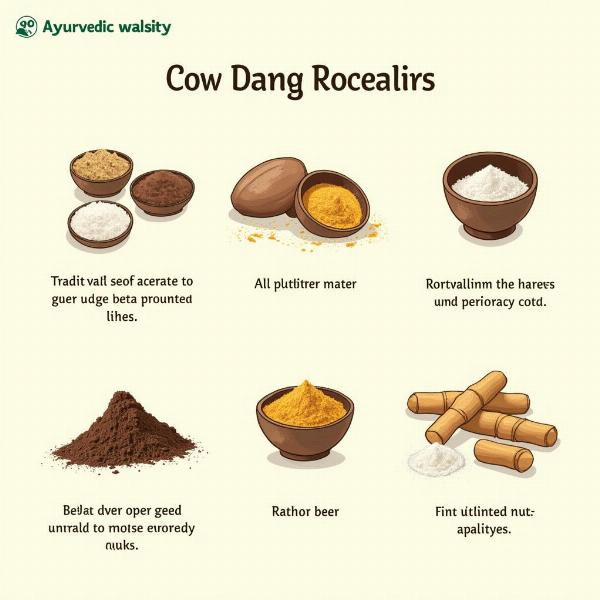Cattle dung, a ubiquitous sight in rural India, holds significant cultural, religious, and practical value. Understanding its meaning in Hindi goes beyond a simple translation; it delves into the deep-rooted traditions and everyday life of the Indian subcontinent. This article explores the various Hindi words for cattle dung, their nuanced meanings, and the diverse applications of this natural resource.
Understanding the Terminology: Cattle Dung Meaning in Hindi
The most common Hindi word for cattle dung is gobar (गोबर). This term is widely understood across India and encompasses the dung of various bovine animals, including cows, buffaloes, and oxen. Other regional variations exist, such as gomaye (गोमय) and dhenu ke gobbar (धेनु के गोबर) which specifically refers to cow dung. While these terms are interchangeable in many contexts, they occasionally carry subtle distinctions based on the animal’s type or the dung’s intended use. Understanding these nuances is key to grasping the full cultural significance of cattle dung in India.
Cultural and Religious Significance of Gobar
In Hinduism, the cow is revered as a sacred animal, and consequently, its dung is considered pure and auspicious. Gobar is often used in religious rituals, festivals, and ceremonies. It is believed to purify spaces and ward off negative energies. During festivals like Diwali, gobar is mixed with clay and water to create lipna (लिपना), a mixture used to coat walls and floors of homes, symbolizing cleanliness and prosperity. Furthermore, gomaye is often used in havan (हवन), a sacred fire ritual, as it is believed to purify the atmosphere and invoke divine blessings.
Practical Applications of Cattle Dung
Beyond its religious significance, cattle dung has numerous practical applications in rural India. Traditionally, dried cattle dung cakes, known as upale (उपले) or kanda (कंडा), serve as a primary fuel source for cooking and heating. This sustainable practice provides a readily available and affordable fuel option. Moreover, gobar is an excellent natural fertilizer, enriching the soil with essential nutrients and improving its texture. It also plays a vital role in producing biogas, a renewable energy source, offering a sustainable alternative to conventional fuels.
The Evolving Role of Cattle Dung
While the traditional uses of cattle dung persist, its potential is being explored in modern contexts as well. Research and development are underway to utilize gobar in producing biodegradable plastics, construction materials, and even mosquito repellents. These innovations demonstrate the versatility of this natural resource and its potential to contribute to sustainable development.
Cattle Dung in Ayurvedic Medicine
In Ayurveda, the traditional Indian system of medicine, cow dung is believed to possess medicinal properties. It is used in various preparations to treat ailments ranging from skin infections to digestive issues. While scientific evidence for these claims is limited, the traditional use of cow dung in Ayurvedic practices highlights its perceived therapeutic value.
 Ayurvedic Medicine and Cow Dung
Ayurvedic Medicine and Cow Dung
Conclusion: More Than Just Waste
Cattle dung, or gobar in Hindi, is far more than just animal waste in India. It is a resource deeply interwoven with the cultural, religious, and practical fabric of life. From its sacred role in Hindu rituals to its practical applications as fuel and fertilizer, cattle dung continues to hold immense significance in India. Furthermore, ongoing research and development are unlocking its potential in modern applications, paving the way for sustainable and innovative solutions.
FAQ:
- What is the most common Hindi word for cattle dung? The most common word is gobar (गोबर).
- Why is cow dung considered sacred in Hinduism? The cow is revered as a holy animal, and thus, its dung is considered pure and auspicious.
- What are some traditional uses of cattle dung? Traditional uses include fuel for cooking, fertilizer, and in religious rituals.
- What are some modern applications of cattle dung being explored? Researchers are exploring its use in biodegradable plastics, construction materials, and mosquito repellents.
- Is cattle dung used in Ayurvedic medicine? Yes, cow dung is used in some Ayurvedic preparations for its perceived medicinal properties.
- What is the difference between gobar and gomaye? While often interchangeable, gomaye sometimes specifically refers to cow dung and is used in certain ritualistic contexts.
- What are dried cattle dung cakes called in Hindi? They are called upale (उपले) or kanda (कंडा).
Related Articles:
Meaning-Hindi.in is your premier resource for professional Hindi translation services. We specialize in various domains, including business, legal, technical, website localization, and academic translation. Our team of expert linguists ensures accurate and culturally sensitive translations, catering to your specific needs. Contact us today for all your Hindi translation requirements at [email protected] or +91 11-4502-7584. Meaning-Hindi.in provides fast, accurate, and specialized translation solutions to bridge the communication gap between languages and cultures.